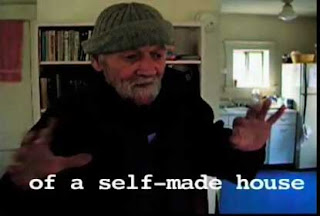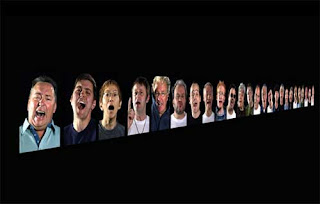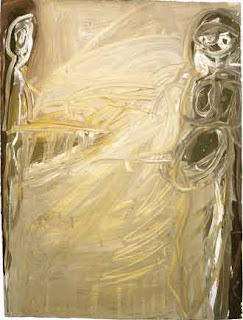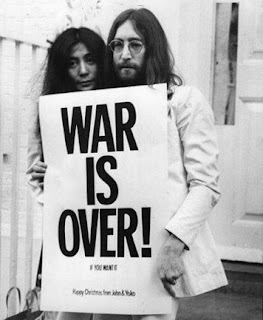Close the door on 2009, but before it is forgotten I remember these moments of brightness.1. The year began and ended with really fine group shows at
David Cunningham Projects, SF.
Trying to Cope with Things that Aren't Human(Part One) I wrote about
here.
Jigsawmentalama was just as good, a kitchen-sink (as in everything but) of a show turning on the idea of transformation, mutation, things being not what they seem. Best-in-show had to go to the prolific
Skye Thorstenson whose
Entheogen films (a set of six) were candy-colored, candy-coated, in a word ravolicious.


Packaged in
Neo-Shaman Medicine Bundles of sequins and beads, these are light-dances of the New (techno) Age. A blessing indeed.
2. The video and installation,
A Self Made House, by
Lydia Greer, in the Master of Fine Arts Graduate Exhibition, UC Berkeley.




"A kaleidoscope telling, dismembering, and retelling of a strange American folk tale" which includes narrative, puppetry, and lots of wonderfully inventive stop-motion. I loved it so much. You can see it
here.
3. Black and white. Good and evil. Right and wrong. Did I say black and white? The pen and ink drawings of
D Young V at
Gallery Three, SF just about knocked me out.

From some fantasy of the world made different after socio-economic collapse,
militaristic images are re-created, localized...

and the children take over. We'll see where this goes...
4.
Odd One Out, the videos and painting installation, by
Julia Oschatz at
Haines Gallery, SF was so intriguing I had to see it twice.

The video in a box of her alter-ego, the gray eyeless dog-mouse, sawing off its ears to paint from the wounds is part Paul McCarthy, part Fischli & Weiss, but mostly other-worldly and I don't mean just because it's jumping off Venus, or maybe because it is.

This animal-soul-KA is often depicted way out in vast landscapes, a speck in the great unknown, lonely and completely endearing.

5. Speaking of endearing... The twenty-five screens of ordinary people simultaneously singing tribute to John Lennon (
Working Class Hero: A Portrait of John Lennon, 2005) was just that, endearing. This was one of two video installations by the brilliant
Candice Breitz showing at
SFMOMA.

The other could have been called Mommie Dearest, but was simply
Mother and I loved every thing about it — the pacing, the repeated small gestures, the overlapping dialog, how it conjured myself, my mother, and every melt-down I've been witness to. Fantastic.

She had great material to work with (no ordinary performers these, Meryl Streep, Diane Keaton, Faye Dunnaway...) but the edit worked the diabolical charm. In a perfect world, its matching pair,
Father, another 6-channel installation (with Harvey Keitel), would have been playing in the next room.
6. In the
Art of Two Germanys exhibit at
LACMA, along with the best of the West, the art-gods Beuys, Keifer, Richter, Baselitz, there was a table-top display of the constructions of a GDR artist,
Hermann Glöckner.
 Cardboard box, cut in two. A teapot torn asunder.
Cardboard box, cut in two. A teapot torn asunder.Heidegger said when an object fails to function as it is, we catch a glimpse of ourselves. What I catch is a glimpse of a world upended and remade all in a simple gesture.
7. The
Franz West retrospective,
To Build a House You Start with the Roof, also at LACMA, was fantastic.
 This one you wear.
This one you wear. This one is huge.
This one is huge.The materiality: plaster, cardboard, paint and glue. The best is paper and flour about which he says, "I have been working in papier-mâché for many years. I came to this material because it's cheap and easy to use. You can make it at home without too many complications. It doesn't bleed. It doesn't stink. And you can live with it without being afraid."*
8. Little art hidden in a bigger show. Called
Stowaways there was, among others, a line of graphite low on a wall (by
Zachary Royer Scholz), a soundscape in the elevator (
Carolina Caycedo), and grease, bar of soap, banana on the floor (
Wilfredo Pietro).

The bigger show was
The Exhibition Formerly Known as Passengers at CCA
Wattis Institute. Small, but certainly beams of light. Huh. Funny, nobody did that.
9. Meeting the bright light
Mark Di Suvero himself at his show of small sculptures at
John Berggruen Gallery, SF — I was completely charmed.

His whirligig steel and stainless sculptures were mighty fine too.
10. But the kicker, the all time high of the year was repeated viewings of the compelling, impressive work of
William Kentridge at SFMOMA.

This is work that does not translate to text — especially this exhibition which included mechanical puppet-film theaters, full-wall 8-channel videos, projections, reflections, etchings, sculptures, animations... I had no idea how involved I would be in the fantastic theatrics of his world. Youtube has a sampling (
animation and
small theater) that gives some flavor of it, but only a taste of the immensity of his achievement. His work is as awesome, moving, and meaningful as art can get.
 Weighing and Watching
Weighing and Watching is a beautiful, evocative film and a perfect example of how he dissolves the boundaries between the personal and political, dream and reality. He says, "I think that one draws knowing what they are, and one has a tendency to be predictable. And a lot of the artwork is trying to find strategies to avoid that predictability, to surprise oneself."** The man is full of surprises. He is a powerhouse.
 William Kentridge takes the cake.
William Kentridge takes the cake.*From the catalog,
Franz West, To Build a House You Start with the Roof: Work, 1972-2008.**From a short by
Associação Cultural Videobrasil.











































